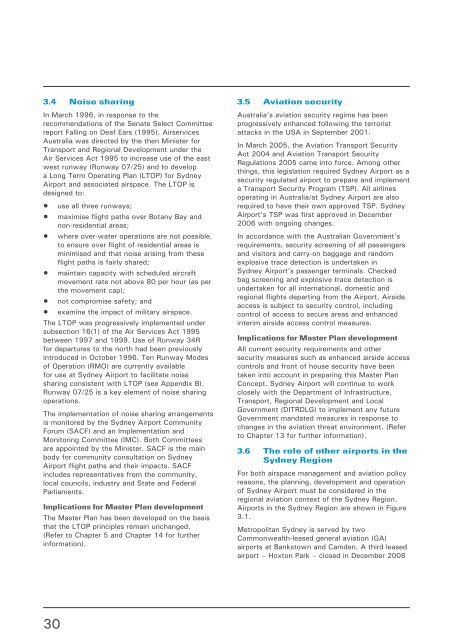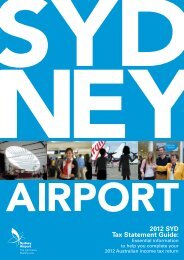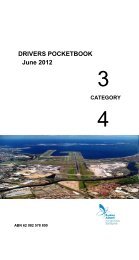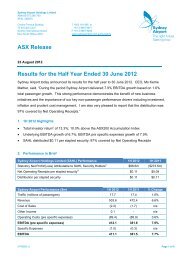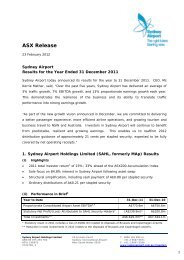Master Plan 2009 - Sydney Airport
Master Plan 2009 - Sydney Airport
Master Plan 2009 - Sydney Airport
Create successful ePaper yourself
Turn your PDF publications into a flip-book with our unique Google optimized e-Paper software.
3.4 Noise sharing<br />
In March 1996, in response to the<br />
recommendations of the Senate Select Committee<br />
report Falling on Deaf Ears (1995), Airservices<br />
Australia was directed by the then Minister for<br />
Transport and Regional Development under the<br />
Air Services Act 1995 to increase use of the east<br />
west runway (Runway 07/25) and to develop<br />
a Long Term Operating <strong>Plan</strong> (LTOP) for <strong>Sydney</strong><br />
<strong>Airport</strong> and associated airspace. The LTOP is<br />
designed to:<br />
• use all three runways;<br />
• maximise flight paths over Botany Bay and<br />
non-residential areas;<br />
• where over-water operations are not possible,<br />
to ensure over flight of residential areas is<br />
minimised and that noise arising from these<br />
flight paths is fairly shared;<br />
• maintain capacity with scheduled aircraft<br />
movement rate not above 80 per hour (as per<br />
the movement cap);<br />
• not compromise safety; and<br />
• examine the impact of military airspace.<br />
The LTOP was progressively implemented under<br />
subsection 16(1) of the Air Services Act 1995<br />
between 1997 and 1999. Use of Runway 34R<br />
for departures to the north had been previously<br />
introduced in October 1996. Ten Runway Modes<br />
of Operation (RMO) are currently available<br />
for use at <strong>Sydney</strong> <strong>Airport</strong> to facilitate noise<br />
sharing consistent with LTOP (see Appendix B).<br />
Runway 07/25 is a key element of noise sharing<br />
operations.<br />
The implementation of noise sharing arrangements<br />
is monitored by the <strong>Sydney</strong> <strong>Airport</strong> Community<br />
Forum (SACF) and an Implementation and<br />
Monitoring Committee (IMC). Both Committees<br />
are appointed by the Minister. SACF is the main<br />
body for community consultation on <strong>Sydney</strong><br />
<strong>Airport</strong> flight paths and their impacts. SACF<br />
includes representatives from the community,<br />
local councils, industry and State and Federal<br />
Parliaments.<br />
Implications for <strong>Master</strong> <strong>Plan</strong> development<br />
The <strong>Master</strong> <strong>Plan</strong> has been developed on the basis<br />
that the LTOP principles remain unchanged.<br />
(Refer to Chapter 5 and Chapter 14 for further<br />
information).<br />
30<br />
3.5 Aviation security<br />
Australia’s aviation security regime has been<br />
progressively enhanced following the terrorist<br />
attacks in the USA in September 2001.<br />
In March 2005, the Aviation Transport Security<br />
Act 2004 and Aviation Transport Security<br />
Regulations 2005 came into force. Among other<br />
things, this legislation required <strong>Sydney</strong> <strong>Airport</strong> as a<br />
security regulated airport to prepare and implement<br />
a Transport Security Program (TSP). All airlines<br />
operating in Australia/at <strong>Sydney</strong> <strong>Airport</strong> are also<br />
required to have their own approved TSP. <strong>Sydney</strong><br />
<strong>Airport</strong>’s TSP was first approved in December<br />
2006 with ongoing changes.<br />
In accordance with the Australian Government’s<br />
requirements, security screening of all passengers<br />
and visitors and carry-on baggage and random<br />
explosive trace detection is undertaken in<br />
<strong>Sydney</strong> <strong>Airport</strong>’s passenger terminals. Checked<br />
bag screening and explosive trace detection is<br />
undertaken for all international, domestic and<br />
regional flights departing from the <strong>Airport</strong>. Airside<br />
access is subject to security control, including<br />
control of access to secure areas and enhanced<br />
interim airside access control measures.<br />
Implications for <strong>Master</strong> <strong>Plan</strong> development<br />
All current security requirements and other<br />
security measures such as enhanced airside access<br />
controls and front of house security have been<br />
taken into account in preparing this <strong>Master</strong> <strong>Plan</strong><br />
Concept. <strong>Sydney</strong> <strong>Airport</strong> will continue to work<br />
closely with the Department of Infrastructure,<br />
Transport, Regional Development and Local<br />
Government (DITRDLG) to implement any future<br />
Government mandated measures in response to<br />
changes in the aviation threat environment. (Refer<br />
to Chapter 13 for further information).<br />
3.6 The role of other airports in the<br />
<strong>Sydney</strong> Region<br />
For both airspace management and aviation policy<br />
reasons, the planning, development and operation<br />
of <strong>Sydney</strong> <strong>Airport</strong> must be considered in the<br />
regional aviation context of the <strong>Sydney</strong> Region.<br />
<strong>Airport</strong>s in the <strong>Sydney</strong> Region are shown in Figure<br />
3.1.<br />
Metropolitan <strong>Sydney</strong> is served by two<br />
Commonwealth-leased general aviation (GA)<br />
airports at Bankstown and Camden. A third leased<br />
airport – Hoxton Park – closed in December 2008


